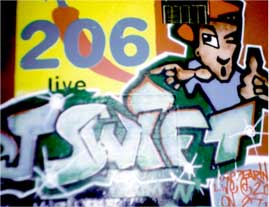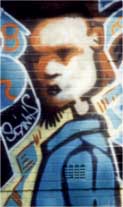|
|
|
|
Patch 1: Well, I've been doing art for years and I could only see one possible way for myself to go as an artist and that was first to look at what others were doing with graf art, and then to take what I knew and to put that into graf. MD: Did you have someone teach you all the basics, show you how to use cans and so on? Patch 1: Yeah, I had a friend who was an established graf artist and he basically instructed me on the way letter formation works, the way characters are displaced, what respect is among graffiti artists, the way things work, the attitudes that go with it. But, at the same time that's quite a British thing, you've got different styles in America and South Africa. MD: Did you start off doing tags? Patch 1: No, I started off doing characters. I'm essentially a character sort of person in a crew, but due to a lack of crews in South Africa I've been doing a lot of learning lettering myself. Instead of doing just one style of lettering I try do as many styles as possible. 
MD: When you set out to do a piece what's the first step you take? Do you sketch it out on paper first? Patch 1: Yeah, I take everything from paper initially to a piece. I look at lettering from someone I admire or do my own and put it on paper and then I show it to people and do what they want - if I'm doing a paid job. MD: Have you ever been caught? Patch 1: Often. But I paint for the community and people normally agree that it looks a lot better than it did before and I can get away with it that way. It happens all the time, we took it from illegal and are making it legal. MD: You've travelled around the world quite a bit, can you name some of the places in which you've done pieces? Patch 1: I've pieced in London, Brighton, Bangkok, Sydney and Johannesburg. I got some good feedback from the crews in Brighton, and the guys I met in Australia thought my stuff was alright. I mainly do pieces for myself, as long as the paint gets paid for. I also do some of them for people I know - to decorate bars and so on and they'd pay for the paint and give me a free meal and drinks and so on. The most memorable piece I did was in Bangkok - it was on the street for a club, in the middle of the day, lots of nice girls walking past, lots of good Thai seafood. I didn't get paid any money, just free paint and food and lots of alcohol.
MD: So, how do you think the South African graffiti "scene" compares to what you have seen in these other countries?
Patch 1: In practically anything us South Africans do, we seem to consider ourselves weak. I'll tell you something, the British consider themselves real strong and I've seen the Australians (who are miles ahead of us) take 'em out and get no credit for it. Especially when it comes to railway graffiti. But we're not there, we're still trying to establish ourselves so you can't really compare South Africans to these people. We're only starting now. Even if you look back 10-15 years in the Cape Flats, the styles aren't where the Europeans are, they're way ahead. But South Africa will get there. MD: And locally, do you see any differences between what happens in Cape Town and Joburg? Patch 1: I don't know, I don't really see a lot of difference at the moment. We've got a lot of varying and different styles, a lot of Cape Town guys have been influenced by America and Holland, Germany - the likes of Loomit and Can-2. They've already put their styles down there and those guys are going to copy that style. Me, I got a style that I learnt on the South Coast of England. Gogga (renowned Johannesburg graf king) has a style that's reminscent of some guys in France. But you can't say that either city has an established style - there's too few artists.
|
 Mass Dosage: The question I have seen many new graffiti artists struggle with is where and how to begin. How exactly did you get involved in doing graffiti?
Mass Dosage: The question I have seen many new graffiti artists struggle with is where and how to begin. How exactly did you get involved in doing graffiti?